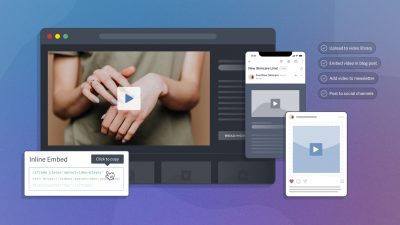Whether you are just getting started with online video, or are regularly sharing it online, growing your audience is key. However, it can be really challenging to rise above the noise and stand out from the crowd.
In this post, we cover five key steps that lay out exactly how to create and scale an audience for your online videos.
1. Find Your Voice
In case you live under a rock, the internet is brimming with content. To rise above the noise, quality counts, but so does individuality.
If you think about the true breakout YouTube stars, they are not corporate brands shilling their wares with increasingly costly and dramatic short form content. Instead, many are vloggers who have quirky presentation styles and have doubled-down on their niche.
For example, beauty vloggers like Michelle Phan actually have more subscribers – and a more engaged audience – than the colossal makeup brands they often use to create different looks, like Dior, Chanel, and Estee Lauder, among others.
Finding your voice means identifying the reasons why you love the topic you are focused on, and what about it excites you the most. It also requires consistency of style and tone.
That is not to say you should be boring – quite the opposite. You can mix up your presentation, incorporate multimedia, shoot in different locations, even be gimmicky, and still present yourself in a reliable and familiar manner. This helps establish your brand, and endear yourself to your audience.
2. Identify (With) Your Audience
You can start by analyzing any available data about your existing audience. If possible, look to traffic on your site, customer service emails, demographics, and any other details that help you uncover details about your target viewers.
Don’t have a site yet? Don’t panic – you just have to look elsewhere for that information. Who are your competitors and who are their customers? Look for any industry analyses and annual reports you can get your hands on.
The goal is to understand who your audience is and what is important to them. You can find relevant data points in a variety of places.
Next, dive into the nitty gritty and investigate common interests members of your audience share. Look for influencers in your space, and see what they share that resonates with their followers.
Social media – especially Twitter – is a great place to start. Also, topical forums like subreddits can be a great place to find people who are truly passionate about a specific subject or industry.
Look for people really active in the space to get a sense for trending topics and common interests. This is an exercise in learning and connecting, not a chance to showcase your expertise or practice your pitch (that comes later).
3. Strategize Your Distribution
Think through what you want to achieve with video. Where does it fit in your marketing funnel? Are you trying to drive new traffic to your site, get email list signups, or convince people to buy your product? Your goals will define how you write, shoot and edit your videos.
It will also define where you want to publish your videos. Since you just analyzed your audience, you should know where they hang out and discover content. Although YouTube is the default for many, it is not always the best answer for hosting video. If you need security and marketing tools, in-depth analytics, and live customer support, consider a professional video hosting platform like SproutVideo.
Certainly, social platforms like Facebook, Twitter, Instagram, Linkedin, and YouTube have a place in your content distribution strategy. You can use them to seed highlight reels, teasers, or more light-hearted fare than you usually publish on your main site or blog.
Be sure to link back to your main website so anyone who is interested in you or your products knows where to click. Again, it all comes back to what you want to achieve with video.
4. Start Creating Content
Get that camera out and start filming! To acquire an audience, fresh, quality content is key. You might be wondering why we didn’t put this step before #3. The reality is that you need to know where the video is going to live and who it might appeal to before you can create it. For reasons ranging from content limitations to discovery and share-ability to privacy concerns, different videos belong on different channels, even if they are addressing the same specific topic and content need.
A huge advantage to video is you can cut one shoot many different ways, and greatly streamline your video production process, saving both time and money in the long run. For instance, if you film a product explainer video, you can cut a short highlight reel for Instagram and Vine, and a slightly longer one for YouTube, all with links back to your site to see the full video. For the video posted on your site, you can then set up a call-to-action or email sign-up form for the post-play screen, and capture leads or help drive conversions.
According to ReelSEO, the video content creators with the most active and engaged audiences publish video multiple times a week – some even do so everyday. That may seem daunting, but using our tips for streamlining your video content creation process, you can create a schedule, and stick to it.
5. Test, Scale, Repeat
Some videos will get more engagement than others. Test different topics, angles, landing pages, titles, descriptions, calls-to-action, social sharing buttons, hashtags, video distribution channels, etc. Everything is being scrutinized here. What you are looking for is popular content, the least popular content, viewer engagement, commenting, and in many cases, social sharing.
A key stat that can help evaluate the performance of different videos is the video play rate. Play rate is equal to the number of total plays divided by the total impressions the video received (impressions are the number of times a video loaded on a page). Dive even deeper, and look at whether or not people watched the whole video, how many times they watched it, where they were located, and their browser, device, and operating system.
Then, look at how many people clicked your call-to-action, or whether they signed up for your email list or eventually converted. This should give you a great sense of who is engaging the most, and the least, with your content. Take those lessons and use them to improve your content, video distribution, and calls-to-action, driving greater audience engagement and acquisition.
Hopefully these five tips help you engage viewers and grow your content network. Did we miss any key action items that have worked for you? Please comment with your best tip below, or share with us on Twitter.








